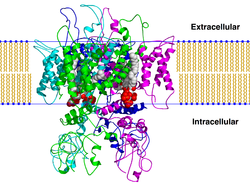Transient Receptor Potential Vanilloid 1
| Transient Receptor Potential Vanilloid 1 | ||
|---|---|---|

|
||
| Ribbon model of the TRPV1 (modeled) with membrane schematic drawing | ||
| Properties of human protein | ||
| Mass / length primary structure | 839 amino acids | |
| Secondary to quaternary structure | Homooligomer; Heterooligomer | |
| Identifier | ||
| Gene name | TRPV1 | |
| External IDs | ||
| Transporter classification | ||
| TCDB | 1.A.4.2.1 | |
| designation | TRP-CC family | |
| Occurrence | ||
| Parent taxon | Vertebrates | |
The transient receptor potential cation channel of subfamily V (for vanilloid), subtype 1 ( TRPV1 for short , from " transient receptor potential cation channel subfamily V member 1 "), obsolete Vanilloid Receptor 1 ( VR1 ) or capsaicin receptor , is an ion channel in the sensory nerve cells of the central and peripheral nervous system of the vertebrates , which, as a "pain receptor", is responsible for the perception of a series of current or potentially tissue-damaging, often painful stimuli. Because of its importance for the development of pain, TRPV1 is an important research object in the development of new analgesics for humans. The receptor also plays a role in the perception of sharp taste .
The transport equation is:
- Ca 2+ outside Ca 2+ inside
General
TRPV1 is a transmembrane protein in the nerve cells of the central and peripheral nervous system that belongs to the family of TRP ion channels . It is assumed that TRPV1 mostly appears as a tetramer of four identical subunits, each 839 amino acids long in humans, with a closable pore in the middle. The receptor was first described in 1997.
functionality
TRPV1 can be activated by a number of influences that are mostly perceived as harmful. These include high temperatures above 42 or 43 ° C and a reduced pH value below 5.9. The receptor is also sensitive to certain activating substances, so-called agonists , the best-known representative of which is capsaicin from paprika and chilli peppers, which promotes spiciness . TRPV1 is activated by psalmotoxins , vanillotoxins , DkTx and RhTx .
When activated, the receptor pores open so that the cell membrane becomes permeable to calcium ions . The resulting depolarization of the cell membrane triggers an action potential , which is propagated via the nerve tracts and leads to pain perception in the brain .
Development of pain medication
Because of its role in pain perception, TRPV1 is an important starting point in the development of new analgesics . The administration of capsaicin to pain-afflicted patients is described in the literature. The permanent irritation of the receptor leads to desensitization and consequently to reduced sensitivity to the pain stimuli mediated by TRPV1.
Another approach is the administration of antagonists . These are substances that prevent the opening of the receptor pores through biospecific interaction with the TRPV1 receptor. As a result, calcium ions can no longer pass through the membrane and the creation of a pain-inducing action potential is prevented. The development of new TRPV1 antagonists for use in pain therapy was and is the subject of research programs in the pharmaceutical industry . It has proven to be problematic in the clinical testing of some drug candidates that there have been isolated increases in body temperature. Furthermore, it is reported that the test persons were less sensitive to heat, which could increase the risk of burns in everyday situations (e.g. hand on stove).
Individual evidence
- ↑ InterPro : IPR024863 Transient receptor potential channel, vanilloid 1 (English)
- ↑ TCDB : 1.A.4
- ↑ M. Cui, P. Honore, C. Zhong, D. Gauvin, J. Mikusa, G. Hernandez, P. Chandran, A. Gomtsyan, B. Brown, EK Bayburt, K. Marsh, B. Bianchi, H. McDonald, W. Niforatos, TR Neelands, RB Moreland, MW Decker, CH Lee, JP Sullivan, CR Faltynek: TRPV1 receptors in the CNS play a key role in broad-spectrum analgesia of TRPV1 antagonists. In: J. Neurosci. 26 (37), 2006, pp. 9385-9393.
- ↑ protein sequence . Retrieved February 7, 2012.
- ↑ a b M. J. Caterina, MA Schumacher, M. Tominaga, TA Rosen, JD Levine, D. Julius: The capsaicin receptor: A heat-activated ion channel in the pain pathway. In: Nature. 389, 1997, pp. 816-824.
- ↑ M. Tominaga, MJ Caterina, AB Malmberg, TA Rosen, H. Gilbert, K. Skinner, BE Raumann, AI Basbaum, D. Julius: The cloned capsaicin receptor integrates multiple pain producing stimuli. In: Neuron. 21, 1998, pp. 531-543.
- ↑ a b c M. Geron, A. Hazan, A. Priel: Animal Toxins Providing Insights into TRPV1 Activation Mechanism. In: Toxins. Volume 9, number 10, October 2017, p., Doi : 10.3390 / toxins9100326 , PMID 29035314 , PMC 5666373 (free full text).
- ↑ P. Holzer: Capsaicin: cellular targets, mechanisms of action, and selectivity for thin sensory neurons. In: Pharmacol. Rev. 43, 1991, pp. 143-201.
- ↑ NR Gavva include: Pharmacological blockade of the vanilloid receptor TRPV1 elicits marked hyperthermia in humans. In: Pain. 136, 2008, pp. 202-210.
- ↑ Modeling and Simulation for Determination of the Therapeutic Window of MK-2295: a TRPV1 antagonist. (PDF file; 580 kB). Retrieved February 7, 2012.
